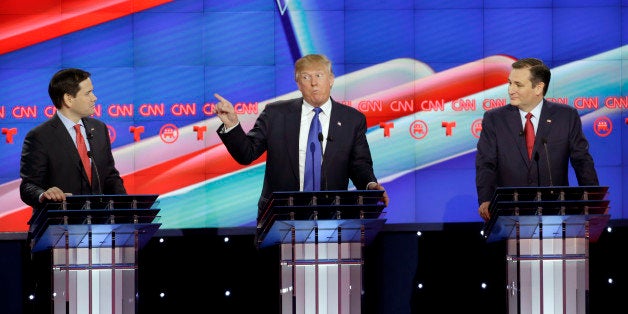
Things do not look good for the Republican Party this year. Split between three factions--Populists and Trump, conservatives and evangelicals for Cruz, and an establishment candidate--it looks like the GOP will split badly, possibly letting a unified Democratic Party into the White House.
Can they recover from this? A quick reading of history implies the answer may be 'yes.' The classic conservative setback, Goldwater's devastating defeat in 1964, was followed by Republican victories in 1968 and 1972 (the later another landslide year, this time for the GOP), and soon after, the Reagan revolution. A closer look at historical evidence, however, reveals far grimmer prospects for the Republicans.
There are a number of precedents that point up the problems they face, and may portend their future. The most obvious is 1912, when the Republicans split wide open, with Teddy Roosevelt launching a third party and polling substantially better than the GOP establishment's candidate, William Howard Taft. Woodrow Wilson won that year in what is generally considered a reflection of the unified, progressive mood of the country.
Both Teddy and Wilson were reformers; if we combine their totals we get a sense of national sentiment, an indication of support for change vs. Taft's standpat conservatism. And the voting results revealed a clear mandate: W/R v. Taft popular vote, 10,414,893-3,487,937; electoral, 523-8. In other words, at that time a candidate could ride a consistent national sentiment to success. Then, as early as 1916 the Republican Party came together, with both Roosevelt and Taft supporting the nominee: Charles Evans Hughes, governor of the biggest state (New York) and a progressive reformer who fit the mood of the times. Hughes lost to Wilson in 1916, but ran an extremely close race (unlike Taft in 1912), and revived the party.
There are two reasons this scenario is unlikely to repeat itself today. First and most important, there is no clear trend as to which direction the nation's mood and politics is heading, unlike in the 20th century. The grim reality is that the Democratic-Republican fights we have seen recently, and the GOP's factionalization, accurately reflects a fragmented public sentiment. The nation is groping agonizingly for a new identity and a new ethos in the 21st century, amidst profound shifts both at home with the technology revolution, and abroad with deep changes in the world order. In other words, politics is as chaotic as the public spirit today. There is no consensus attitude for the GOP to coalesce around, as they did after 1964.
The other reason this analogy fails is that there is no public figure likely to unify the three wings of the Republican Party mentioned at the outset, as Hughes did in 1916. Quick quiz: name a candidate both Donald Trump and Ted Cruz could back. Easy answer: there is none.
A more likely scenario resembles the Democratic Party after 1896, a year when they split over the Populist revolt and ran William Jennings Bryan, representing Midwestern and Southern farmers. After that episode they stuck with the insurgent faction for twelve years; in the four elections between 1896 and 1908 the Dems actually ran Bryan three times, again and again and again, unable to move on. They then finally won with Woodrow Wilson, a Northern governor tied to the prevailing reform sentiment, in 1912 and 1916. After that the Dems lost every election till 1932 and Franklin Roosevelt's candidacy, riding not just dissatisfaction with a country in depression, but also the demographic revolution of immigrants and urban voters that had been building for years.
Again, this story brings little hope for beleaguered Republicans today. As noted above, unlike 1912 when there was a clear mood that Wilson/TR represented, the country is fragmented now. It is also unlikely that they will settle on a single mainstream candidate as they did with Hughes in 1916. FDR's victory is an even more ominous marker, however. The major demographic trends in the nation right now, as in the 1930s, are introducing waves of new voters opposed to the party of Lincoln, not supporting a party comeback, as happened for the Democrats in 1932.
The best analogy, therefore, may be from a state election rather than national contests. In 1994 the California GOP under Governor Pete Wilson launched Proposition 187, which denied state services like health care and public education to illegal immigrants. Although it passed, courts struck it down later. More importantly, it transformed politics in the Golden State, branding Republicans as the anti-immigrant party and essentially nullifying their future. At present no member of their party holds statewide office, and their registration keeps dropping. This is the complete reversal of what FDR and the Dems accomplished eighty years ago, alienating and not harnessing a changed electorate.
Yet this year holds the possibility for the national Republican Party to repeat what it's California branch accomplished in 1994. Without a national leader to reshape their image, if the GOP gets branded as the party of Trump for emerging blocks of Latin-American and Asian voters, and the party of Cruz for millennials, their prospects for the future look dark.